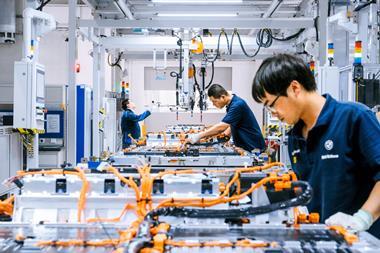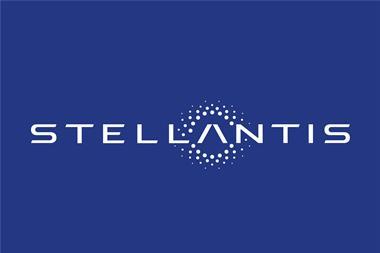
Quality and automation are intrinsically linked when it comes to automotive welding operations.
Enhancing the level of automation in the welding process cannot be achieved without associated weld quality monitoring systems. Put simply, any auto plant willing to switch off its manual element needs to implement process safeguards that ensure the equipment doesn’t produce high levels of costly rework or scrap.
“For welding in the automotive industry we are seeing continuing trends towards increased quality control and automation – the two go hand in hand,” confirms Dave Park, global business segment director (transportation) for Lincoln Electric. “Machine controls continue to become smarter, which allows companies such as Lincoln Electric to design quality control features into welding equipment and automated systems.”
As an example, Park cites Lincoln Electric’s cloud-based weld management system, called Checkpoint, which enables users to obtain performance information on their welders and welding operations from any location, via any computer or almost any mobile device. With capabilities such as this, welding operations can be monitored in real time, with weld performance measured instantaneously.
To ease the adoption of automation across the automotive welding landscape and address skills issues, Lincoln Electric says it has recently purchased two substantial automation integrators in the United States and is building an advanced automation centre in Mexico.
“From Lincoln Electric, look for more quality control capability integrated into the electronics of the company’s semi-automatic and manual welding offerings,” says Park.
Kemppi is another technology supplier with a vested interest in quality control. The company’s flagship product for welding quality management is the new 2.0 version of the Kemppi Arc System and its ArcQuality module.
According to Kemppi, ArcQuality is the world’s first welding quality management system to offer an easy and comprehensive way of ensuring adherence to welding procedure specification (WPS) documents. It also checks that the welders’ qualifications meet the specified requirements throughout the project. In addition, the system breaks ground in enabling the user to anticipate servicing needs, while the smart scanning device functionality can collect quality-related documentation for traceability of every individual weld.
The dimensional quality of a welded assembly depends to a large extent on the correct positioning of the robot during the welding operation. Therefore, in-line gauging solutions supplier Perceptron says it has implemented a number of systems for various applications, such as bumper bracket welding or hinge welding for closure panels. Here, optical sensors guide welding robots to an exact spot, taking into account the relative positions of the components being welded together. Since the robot guidance system is a fully equipped gauging system, the resulting dimensional quality can be verified directly after the welding operation, with the same set of sensors.
According to Perceptron, hinge welding cells installed recently at a car manufacturing plant in Spain rely on a robot-mounted optical sensor locating all three sides of a door hinge along a single robot path in less than seven seconds. At a later date in this challenging project, Perceptron’s new family of 3D scanning sensors, called Helix, will also be employed to check the distance between the hinge and the outer door skin in order to ensure they are flush after welding.
 Quality control also forms an important part of ongoing research programs into automated welding. For instance, as part of its continuing involvement in the European Research Agency FP7 framework, TWI is currently co-ordinating the Marwin project, which aims to develop a vision-based welding robot with automatic track calculation, welding parameter selection and an embedded quality control system.
Quality control also forms an important part of ongoing research programs into automated welding. For instance, as part of its continuing involvement in the European Research Agency FP7 framework, TWI is currently co-ordinating the Marwin project, which aims to develop a vision-based welding robot with automatic track calculation, welding parameter selection and an embedded quality control system.
There are huge commercial advantages in the development of a flexible robot that can be set up quickly and switched between welding lines as and when required. Doing this with existing welding robots usually results in the need for reprogramming, which is time consuming and therefore expensive. Marwin offers a potential solution to this problem, which can reduce manufacturing time, and costs, increase production flexibility and efficiency, and improve product quality.
TWI is acting as Research Technology and Development (RTD) project co-ordinator and is also responsible for all welding-related tasks, including the development of welding procedures for commonly used materials and joint configurations, as well as the management of a welding parameter database. Other partners in the project include Rolan robotics (Netherlands), Nemetschek (Bulgaria), G-robots (Hungary), Recam Laser (Spain), Sheffield Hallam University (UK) and MFKK (Hungary). The project is expected to reach its conclusion by the end of the year.
At the heart of Marwin will be a computer that controls both the vision system and the welding robot. A 3D image of the components will be reconstructed by the vision system using structured light and pattern recognition, and will be compared to a CAD drawing of the assembly. The computer then determines the best trajectory for the robot from the user input.
Adjustments to the trajectory are made automatically from the reconstructed image, while welding parameters will be chosen automatically from an in-built database. Users will also be able to add their welding procedures or modify existing ones. The Marwin system will be compatible with any production welding robot.
Back in the here and now, quality is firmly in the driving seat on most auto plants’ welding lines. Take the Ghent, Belgium plant of Volvo, where the V40 rolls off the production line, and where the production team relies on measuring systems from Hexagon Metrology. According to Volvo, metrology is most important for the weld lines in ‘A-Shop’. Here, random inspections of the bodies-in-white are performed automatically on the weld lines in bypass on two DEA Bravo HP systems from Hexagon. The open design of the dual horizontal arm measuring machines simplifies the loading of the bulky bodies-in-white.
Either tactile or optical sensors can be selected and among the features checked are the positions of the welded studs, which are used to attach specific parts in a pre-determined position. These are measured using the CMS106 laser sensor, while the PC-DMIS software package compares the measured data with the CAD data.
But why go for optical and not tactile? Well, when measuring with tactile probes the irregular shape of the studs creates a bottleneck. In earlier days, only tactile probes were available at Ghent. To achieve accurate results metrologists had to place plastic cylinders on the studs, a manual intervention which took time. Also, after several measurements, the cylinders were worn and had to be replaced.
Another time-killer saw the measuring systems once placed in a measuring room. The bodies-in-white had to cover a greater distance in comparison with the new in-line concept – the whole procedure could take three hours. Today, after 20 minutes the sensors reveal the positions of the more than 170 connecting pins on a Volvo car body. With the in-line system and the optical sensor, the procedure is some nine times quicker.
Even troublesome part characteristics or poor ambient light immunity have no effect on accuracy of CMS106, says Hexagon Metrology, whereas conventional optical sensors have to struggle against material characteristics and light issues. For example, refl ections from the part’s surface interfere with data capture.
The CMS106 generates a laser line, consisting of several points, which is used to scan the surface of the car body. The laser line and laser intensity are adjusted to suit the part and the light conditions. As a result, interfering factors can have no effect on measurement accuracy.



































